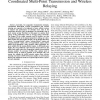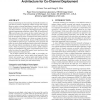85 search results - page 17 / 17 » On Cellular Capacity with Base Station Cooperation |
GLOBECOM
2010
IEEE
13 years 8 months ago
2010
IEEE
Currently, two cooperative transmission strategies, Coordinated Multi-Point (CoMP) Transmission and wireless relaying, are expected to be deployed in future cellular systems to imp...
INFOCOM
2003
IEEE
14 years 4 months ago
2003
IEEE
— As CDMA-based cellular networks mature, the current point-to-point links used in connecting base stations to network controllers will evolve to an IP-based Radio Access Network...
TWC
2008
13 years 10 months ago
2008
Abstract--In a cellular distributed antenna system (DAS), distributed antenna elements (AEs) are connected to the base station via an offline dedicated link, e.g. fiber optics or l...
MOBICOM
2010
ACM
13 years 11 months ago
2010
ACM
Femtocell technology has been drawing considerable attention as a cost-effective means of improving cellular coverage and capacity. However, under co-channel deployment, femtocell...
INFOCOM
2010
IEEE
13 years 9 months ago
2010
IEEE
—In IEEE 802.22 Wireless Regional Area Networks (WRANs), each Base Station (BS) solves a complex resource allocation problem of simultaneously determining the channel to reuse, p...


